Real-life shark attacks aren’t usually as dramatic as what we see in the movies, but they are bone-chilling to hear about. Although rare and typically never fatal, a number of shark attacks happen every year, and the first one of 2023 is especially terrifying. Keep reading to learn about the early January encounter!
Are Shark Attacks Common?
Shark attacks aren’t as common as the media makes them out to be. Annually, only about 80 unprovoked shark attacks occur across the globe, and they rarely result in death. Statistically, you are more likely to die from a lightning strike, car accident, or drowning, than at the hands (or mouth) of a shark. In fact, you only have about a one in four million chance of dying from a shark attack.
Why Do Sharks Attack Humans?
Sharks don’t actively hunt humans. Unlike man-eaters such as polar bears, crocodiles, tigers, and lions, sharks only attack humans when they are confused, curious, or sense danger.
Sharks mainly eat fish, seals, sea lions, and other smaller sea mammals. From under the surface, surfboards look a lot like common shark prey. For example, attacked surfers are often mistaken for a sea turtle or seal. Because these attacks are due to misperception, the shark will usually let go soon after the initial bite. Additionally, sharks are curious animals. They will investigate anything that splashes quickly or makes noise, and their investigation may result in an attack.
Great white sharks are almost always involved in the most fatal shark attacks, but they aren’t the only dangerous shark. Bull sharks, tiger sharks, and shortfin makos also sometimes attack humans.
The First Shark Attack of 2023
The first fatal shark attack of the year happened on January 5th. Manuel Lopez was diving for mollusks in Tobari Bay, Mexico at around 11:30 am. He was at depths between 36 to 59 feet when he was attacked and killed by a 19-foot great white shark. The massive great white bit off the diver’s head! Manual also sustained injuries to his shoulders.
Divers were aware of great white shark activity in the area. Sharks are common in Tobari Bay, especially during December and January when pregnant sharks migrate to the area. These females seek out high-fat foods like sea lions, since they need to eat a higher calorie count. Some experts believe that when divers wear black, they are easier to mistake for a sea lion or seal.
About Great White Sharks

Great white sharks grow up to 19 feet long, the exact size of the huge shark that killed Manuel Lopez.
©Tomas Kotouc/Shutterstock.com
Great white sharks are also known as white sharks. They are massive, weighing up to 4,400 pounds, and growing up to 19 feet long during maturity. These large sharks are found all over the world and they live about 70 years. Great white sharks are predatory fish, but their only known predators are humans and sometimes large orca whales. There is still a lot we don’t know about great white sharks. They live mysteriously, disappearing into deep waters.
How Many Shark Attacks Happened in 2022?
In 2022, there were 137 shark attacks in the world. However, 62 attacks were provoked, 14 were unconfirmed, and only eight resulted in fatalities. The United States saw the most shark attacks of any country. The number of US attacks increased from 2021 to 2022, likely because Covid-19 related lockdowns eased in 2022, meaning more people were traveling and visiting beaches.
Where is the Shark Capital of the World?

New Smyrna Beach, Florida is a hot spot for shark attacks.
©iStock.com/Javier_Art_Photography
Most shark attacks happen in the United States. The shark capital of the world is Florida. In 2021, this state accounted for about 60% of all shark attacks in the country and 38% of unprovoked attacks worldwide. Florida sees millions of visitors every year, drawn to its countless beaches, some of which are quite dangerous. For example, New Smyrna, Cocoa, and Daytona beach are hot spots for shark attacks. According to experts, swimmers in New Smyrna are always within 10 feet of a shark! If you brave such waters and want to avoid a shark attack, avoid splashing and do not swim at dawn or dusk.
Up Next
- Where are the Most Shark Attacks in the World?
- Florida Shark Attacks in 2022: The Complete List
- The Deadliest Shark Attack in Human History
- 7 Islands With the Most Shark Attacks
The photo featured at the top of this post is © Vincent Legrand/Shutterstock.com
Thank you for reading! Have some feedback for us? Contact the AZ Animals editorial team.







